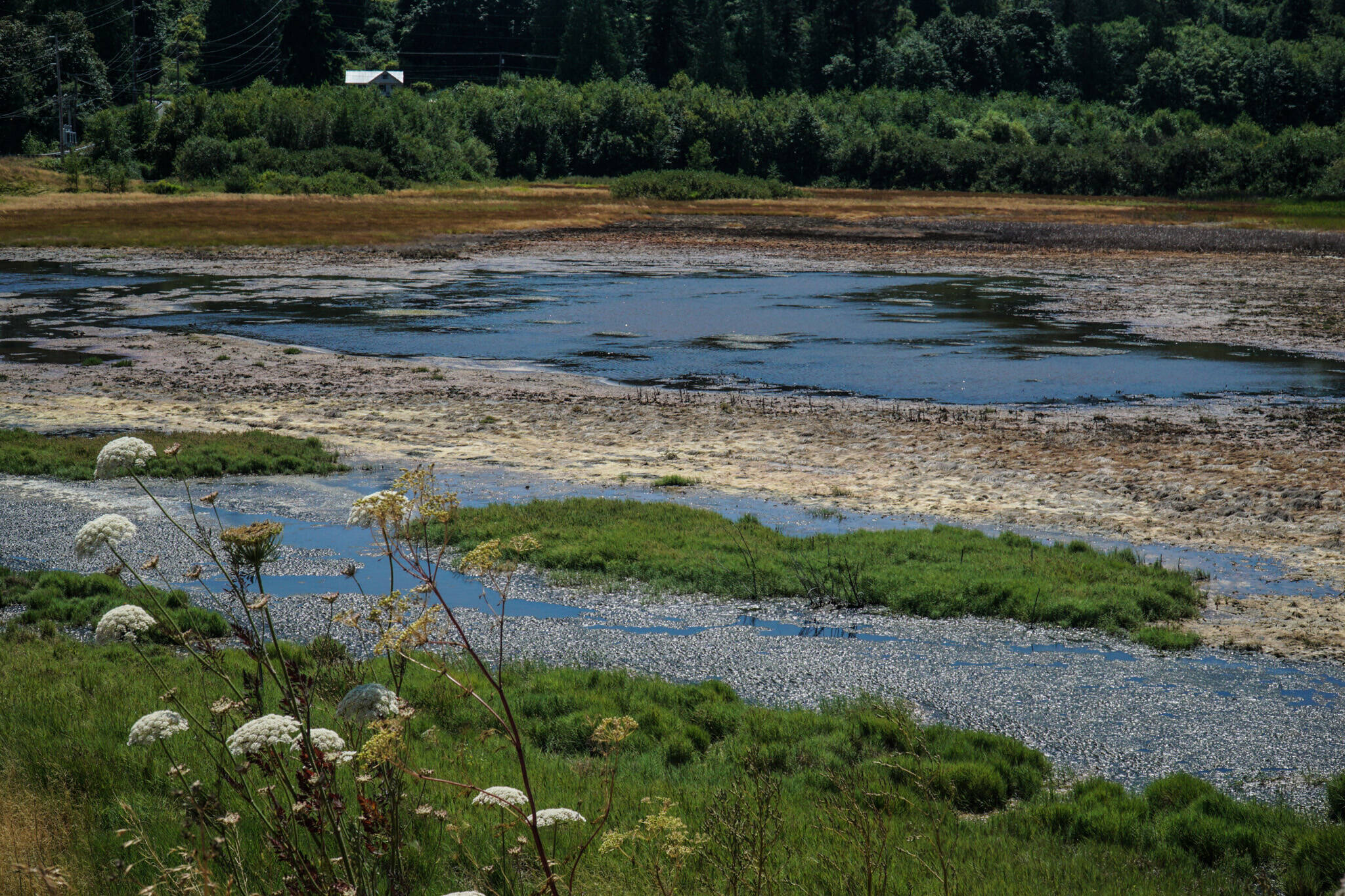A low-key but important migration is happening on North Whidbey this month.
The western toad, a large warty amphibian native to the island, breeds in freshwater wetlands and hatches its young around this time of year, which will migrate to the forest and live their adult lives there until they return to the wetlands to breed.
Western toad eggs fill a lagoon within the Dugualla Bay Preserve, according to Kyle Ostermick-Durkee, a stewardship specialist with the Whidbey Camano Land Trust. When the young toads are ready, they will hop across some of the farm fields and the wetland habitats into the uplands, hopefully dodging passing cars.
“If you were to drive this time of year on Jones Road, which is north of there, you’ll see, unfortunately, lots of splattered toads,” Ostermick-Durkee said.
While the western toads are a candidate species for the state’s endangerment listing, identified as a species of greatest conservation need under the state wildlife action plan, they likely do better on Whidbey than many other areas, Ostermick-Durkee said. This is in part due to the efforts of local organizations such as the land trust and the Whidbey Environmental Action Network.
Western toads range in color from brown, green, olive, gray and maroon, with a blunt head, stout body, broad waist, short legs and warty skin. They make a mellow “chirrup” or high pitched “plinking” sound and, according to the state Department of Fish and Wildlife, many males vocalizing together sound like cackling Canadian geese. They persist in every single ecoregion Washington has to offer.
Ostermick-Durkee explained that the Jones Road area is likely home to the biggest toad migration on the island. Yet every time a road is built and habitats are parceled, it becomes harder for the toads to journey between wetland and upland forests.
This migration shows why the toads are important, he said. Toads, like all amphibians, are an indicator of habitat connectivity in ways other types of animals aren’t, as they cannot complete their lifecycle unless a multi-faceted habitat, such as a cohesive wetland and upland passage, is intact.
Western toads are not glamorous, said Marnie Jackson, executive director of the Whidbey Environmental Action Network or WEAN.
“It doesn’t make a good cover model like the panda or the lion does,” she said.
That said, toads are indicative of human health, she said. Improving toad habitat contributes to the quality of the aquifer humans pull drinking water from. Because of this, WEAN successfully fought Island County in court to ensure the amphibian is protected in the critical areas ordinance.
Preventing new roads near known western toad habitats is an official recommendation from Fish and Wildlife, as is developing educational signage and testing for fungal and trematode infections.
Whidbey’s toads have likely not been studied enough for officials to understand how traffic on Jones Road impacts their population, Ostermick-Durkee said.
“Many toadlets certainly make it across the road, but are their numbers staying steady year-over-year? I couldn’t say,” he said.
Closing Jones Road, even if recommended, would almost certainly not be feasible, he said, as it’s the primary ingress and egress for residents of that area, and the toad migration persists for weeks.
A better solution, he said, would be to rebuild a section of Jones Road with tunnels beneath for the toads to cross under. A notable example of this was completed for toads at Yosemite National Park.
As tadpoles, western toads have an equally impressive migration. As the toads lay their eggs in spring, come morning time tadpoles come together — at times in the thousands — forming a large, black cloud beneath the lily pads and freshwater. The sleek black tadpoles move together, forming a river of bodies, dodging the attacks of water bugs and leeches, to get to shallower water, getting their fill of algae along the way.
With such dense vegetation and small, dark creatures, this migration is much tougher to spot. But the little toads will do this daily for two months as they metamorphosize. Once the tadpoles have legs, they will continue this migration, clumsily hopping rather than swimming in the water, until they can no longer breathe in water and must move to land.
Whidbey’s western toads have come a long way in more ways than one. Leaders with WEAN have been fighting for their protection for almost two decades. WEAN argued before the Growth Management Hearings Board and in appeals court that the toad should be protected in uplands as well as wetlands.
A judge eventually ruled in favor of WEAN, ordering the county to record where toads are spotted and protect those areas. After 15 years, 1,000 hours of legal work and $50,000 in attorney’s fees, Island County and WEAN reached an agreement on the revised code language to protect the western toad in late 2021, according to the group.
WEAN has recently created a volunteer reporting form for western toad sightings. Though, Jackson noted, citizen science is incomplete and should only supplement governmental resources.
Jackson believes that the county should study where humans and toads interact and respond with seasonal road closures and wildlife underpasses. Without this, WEAN operates in a “vacuum of data” and cannot make proper investments in the species, she said.
Those who spot western toads can report their findings at whidbeyenvironement.org/toad-tracker.


